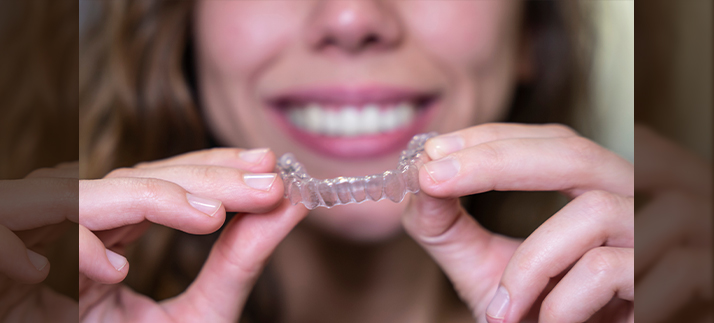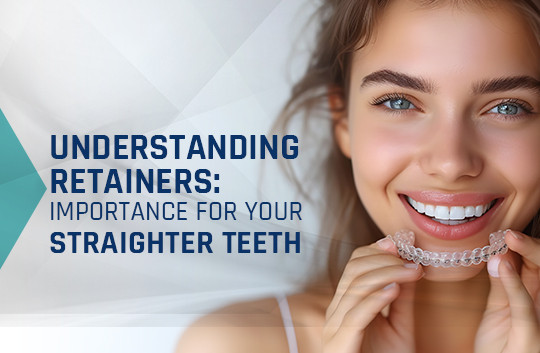

Understanding Post - Braces Gaps: Causes and Solutions
- Causes of Post-Braces Gaps
- Consequences of Gaps between Teeth Post-Braces
- When Do Teeth Stop Moving After Braces?
- Why Gaps in Front Teeth Occur After Wearing Braces
- Factors Contributing to Spaces between Front Teeth
- How Can Braces Be Used to Correct Gaps Between Teeth?
- How Long Does It Take for Braces to Close a Gap?
- How Can You Prevent Gaps from Re-Emerging After Braces?
Do you recall the excitement and sense of achievement when your Invisalign treatment concluded, revealing your perfectly aligned, attractive smile that boosted your confidence? However, what happens if you begin to notice gaps appearing between your teeth after treatment? This situation can be understandably concerning, and you might question the long-term effectiveness of your Invisalign braces. If you're encountering this issue, it's important to know that you're not alone. Many individuals experience similar changes post-treatment. This blog post aims to shed light on why gaps might appear between your teeth after Invisalign and provides insights into potential solutions.
Causes of Post-Braces Gaps
After the removal of braces, some individuals may notice the development of gaps between their teeth. This can be concerning, but it's important to understand that it's a common issue with several potential causes. Our team is dedicated to providing suitable solutions to help you address this problem effectively.
- Retention Phase Challenges The retention phase is an integral part of the orthodontic treatment process. It typically involves wearing retainers to preserve the alignment achieved during treatment. However, in some cases, retainers may not fully prevent the teeth from shifting slightly, which can lead to the formation of small gaps. It's crucial to follow your Invisalign providers instructions regarding retainer use to minimize such shifts.
- Natural Tooth Movement Teeth have a natural tendency to move over time, independent of whether one has worn braces. This movement can be influenced by various factors, including aging, not wearing retainers, changes in your bite, and the daily pressures exerted during chewing. These natural shifts might lead to the development of gaps post-braces. It's important to note that such movements are a normal part of dental maturation and are not necessarily indicative of a failure in orthodontic treatment.
- Elastic Ligaments The ligaments that connect teeth to the jawbone are elastic in nature. This elasticity allows them to exert pressure on the teeth, which can sometimes lead to the teeth moving apart and forming gaps. It’s a natural occurrence and can contribute to minor shifts in tooth positioning post-treatment.
- Genetics An individual's genetic makeup plays a significant role in the size, shape, and arrangement of their teeth. Genetics can make some people more predisposed to developing gaps, both before and after orthodontic procedures. The minor gaps that appear after the removal of braces can be a normal part of the post-treatment process. Our team is dedicated to improving your oral health and provides expert guidance on retainer usage to maintain the results achieved during your orthodontic treatment.
- Incomplete Treatment In some cases, orthodontic treatment might not fully address underlying issues related to misalignment. If the initial treatment was incomplete or if there were underlying concerns not entirely resolved, this could lead to the re-emergence of gaps. It’s important to have a thorough assessment and follow-up with your orthodontist to ensure all aspects of misalignment are addressed.
Consequences of Gaps between Teeth Post-Braces
Discovering a gap between your teeth after completing braces treatment can be a source of concern. It's important to understand the potential implications of these gaps to manage them effectively. Here’s what you need to know:
- Dental Misalignment The presence of gaps may contribute to the misalignment of your teeth. This can affect your bite, potentially leading to discomfort or difficulty in chewing. It's important to monitor any changes in your bite and consult with your orthodontist if you experience discomfort.
- Risk of Dental decay and gum disease Food particles can become trapped in gaps, increasing the risk of cavities, gum disease, and plaque buildup. Maintaining good oral hygiene, including regular brushing and flossing, is crucial to prevent these issues. Regular dental check-ups are also important for early detection and management of any oral health problems.
- Speech Impairment In some cases, particularly with larger gaps, there might be an impact on speech clarity and pronunciation. If you notice changes in your speech, it is advisable to consult with a dental professional. Speech therapy may also be beneficial in some cases.
- Impact on Self-Esteem and Confidence The aesthetic concerns associated with gaps between teeth can significantly affect self-esteem and confidence. This can have implications for social interactions and overall well-being. If the appearance of gaps is a concern, a range of cosmetic dental treatments might be available to help improve the appearance of your smile.
When Do Teeth Stop Moving After Braces?
Teeth may continue to undergo slight movements throughout an individual's lifetime, even after braces have been removed. The immediate period following the removal of braces is known as the "retention phase." This phase is essential for preventing significant shifts in tooth alignment. Orthodontic patients are usually recommended to use retainers in order to preserve the alignment achieved during their treatment.
The duration of the retention phase can vary, depending on the specific orthodontic needs of the individual. Its primary purpose is to allow the bone and ligaments surrounding the teeth to adapt to their new positions. As time passes, the necessity for wearing retainers may diminish, and patients may shift to wearing them exclusively at night.
This night time retention phase will need necessary for life, and the use of a wire retainer helps to dramatically reduce movements also.
As time goes on, the likelihood of significant shifts decreases, but teeth can still undergo gradual changes influenced by factors like natural aging, alterations in one's bite, and dental habits.
To ensure that your teeth remain in their desired alignment, it is advisable to follow your providers instructions regarding retainer use and attend routine follow-up appointments to monitor the progress of your treatment. This proactive approach will help address any concerns promptly and ensure the long-term success of your orthodontic treatment.
Our team of invisalign experts is committed to providing exceptional orthodontic treatment and comprehensive care, along with solutions to help you maintain the results of your treatment.
Why Gaps in Front Teeth Occur After Wearing Braces
It is quite common for individuals who have had their braces removed to notice small gaps between their front teeth. Although this phenomenon may be a cause for concern, there are several reasons why it can happen:
- Natural Tooth Movement Over time, teeth may undergo slight shifts, similar to how the body changes or hair grows with age. This natural movement can lead to the formation of gaps between teeth. If you wore braces for an extended period, it's possible that your teeth have shifted since you last had them on. These gaps are usually temporary and can often be addressed by your dentist. If you observe any changes in your teeth or notice new gaps after braces removal, it's advisable to consult your orthodontist promptly. This will help identify the cause and address any concerns.
- Limitations in Orthodontic Treatment Braces work by applying pressure to teeth to move them into their correct positions. In some cases, it may be challenging to completely close gaps between teeth, especially if the gaps are significant or related to the positioning of your teeth and jaw. Your orthodontist may need to adjust the treatment plan or consider additional procedures to close these gaps effectively.
By addressing these potential causes of gaps between front teeth after wearing braces, you can work with your orthodontist to achieve the desired results and maintain a healthy smile.
Look your best, feel your best,
expect the best.
Contact UsFactors Contributing to Spaces between Front Teeth
Spaces between the front teeth, often known as diastemas, can occur due to a variety of factors. Understanding these factors can help in addressing and managing these gaps effectively.
- Genetics Genetics is one of the primary contributors to the formation of gaps between teeth. The positioning and size of your teeth are largely influenced by genetic factors, which can naturally lead to spaces between your teeth.
- Oral Habits Certain oral habits can contribute to the development of gaps between front teeth. Prolonged use of a pacifier or thumb-sucking during childhood can exert pressure on the teeth, causing them to move apart. Additionally, tongue thrusting, a habit involving the tongue pushing against the front teeth during swallowing, can also contribute to spacing problems.
- Dental Conditions or Injuries Various dental conditions or injuries can result in spaces between your front teeth. For instance, gum disease can cause the gums to recede, potentially leading to the formation of gaps. Similarly, a trauma to the mouth, such as a blow or fall, can cause teeth to shift, creating spaces.
How Can Braces Be Used to Correct Gaps Between Teeth?
Invisalign braces are a commonly used orthodontic method for closing gaps between teeth. Braces, including Invisalign, apply gentle pressure to the teeth, gradually shifting them into their proper alignment and effectively closing the gaps.
How Long Does It Take for Braces to Close a Gap?
The duration required to close a gap with braces can vary from one individual to another. Several factors, such as the size of the gap, your specific dental condition, and your body's response to the treatment, can influence the treatment's duration. In most cases, gaps can be successfully closed within a few months to a year. Your dentist will provide you with a more accurate estimate based on your unique circumstances.
How Can You Prevent Gaps from Re-Emerging After Braces?
If you wish to prevent the re-emergence of gaps between your teeth after braces, it is crucial to adhere to your orthodontist's instructions diligently. This includes wearing retainers as prescribed and attending all post-treatment appointments. Retainers play a vital role in maintaining the new positioning of your teeth and preventing them from shifting back. Consistency and compliance with post-braces instructions are essential for preserving and maintaining your beautiful smile.
Don't let gaps between your teeth after braces prevent you from confidently displaying your beautiful smile. At our Dental Clinic in London, we are well trained in addressing oral concerns, including braces for correcting gap teeth, and providing expert guidance for post-braces care.
While gaps between teeth are not a common issue after undergoing orthodontic treatment, we are dedicated to ensuring that your teeth remain perfectly aligned after braces. Bid farewell to gap teeth with braces and welcome the straighter smile you've always desired. Contact our Invisalign dentist in London for a consultation session to discover how we can help you achieve the perfect smile.
 70 Great Russell St, Holborn, London WC1B 3BN, UK
70 Great Russell St, Holborn, London WC1B 3BN, UK



























